ASI Sugar Cubes
The ASI stands for Acoustic System International, a one-man show of Franck Tchang, a Chinese expatriate living in Paris, France. He is no newcomer to audio which many regular visitors to hi-fi shows can attest –entering as a non-believer and going out as a convert is the usual result of Franck’s demonstrations. The company's original product range consisted only of few resonators, which were essentially small metal bowls laid on three-point prongs on their wooden bases. Today, the resonators are available in several versions and models, from bronze to platinum. Over time, resonators have been joined by cables “that are connecting only on one end” (whoops!), and by small wooden cubes, aptly named Sugar Cubes. Indeed, browsing through the ASI’s portfolio makes one want to stifle a laugh. There is one catch, though: have any of the above properly demonstrated and you will pull out your credit card without an eye blink.
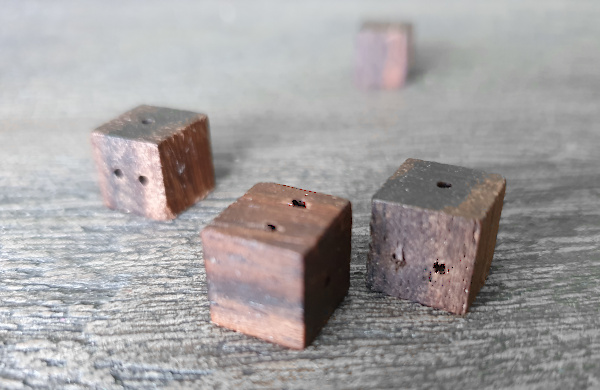
Devil's dice
ASI Sugar Cubes are as simple as they can be, wooden cubes measuring approximately 10x10x10mm. They are formatted from Brazilian rosewood and drilled through with 1mm holes; there is not much precision in cutting and drilling – I would not be surprised if each cube were unique - and that does not bolster confidence. The Sugar Cubes are sold as a set of 17 along with a wooden mini-diffuser, all packed in a plastic bag that fits in a pocket. If there was such a thing as an anti-high-end award, Sugar Cubes might be the prime candidate.
The cubes are quite easy to work with, they need to be attached to the front wall according to the provided drawing (see picture) which is a good start. To attach the cubes to the wall or other materials, use the Blu-Tak or a similar plastic glue that can be purchased at any good stationery store. Such a solution has the advantage that you can repeatedly move, slide, or rotate the cubes, which is the activity that you will be carrying out for several days.
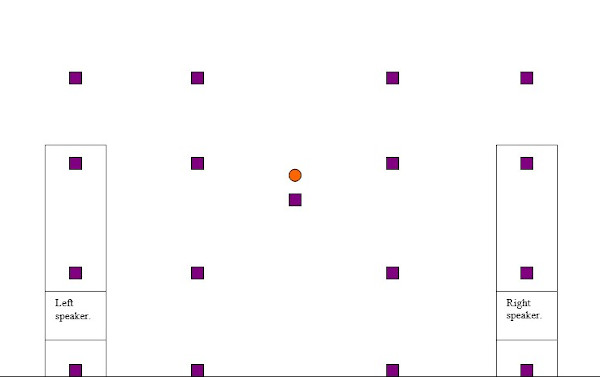
I do not consider placing the ASI Sugar Cubes on the wall in the prescribed grid to be a particularly difficult. For start, the manufacturer's recommendations work very well – they instruct to set up the standard grid, and make it denser where you need damping, or vice versa, place the cubes farther away from each other if you want to preserve the air of the room. I played with this extensively, and because I have my residential acoustics 'just right', I got the best result with the cubes a bit farther apart than the ‘standard’. In the end, I decided to remove four Sugar Cubes from the grid not to dampen the sound too much. The last sentence needs to be read twice: not to dampen the sound too much? Dampen? With a handful of small wooden cubes, really?
Well, just accept the fact that with Sugar Cubes you can drastically alter the sound in a room in any preferred direction, from total deadening to maximum reverb. The only thing is to know how and have courage and patience to start. I consider myself to be a down-to-earth person and my technical background drive me into skepticism when I encounter things that I cannot explain by conventional thinking. Perhaps this was the main reason why - after experiencing the effects of the Sugar Cubes – my audio life has turned upside down and has become divided into the pre-Sugar Cubes and post-Sugar Cubes phases. I see your raised eyebrows and malevolent grin. Then do not continue reading, even more acoustic mysteries are coming. (Editor’s note: I am sure that the last sentence is the right one to make sure that everyone goes on reading. Clever.)
The devil has a lot of sugar, and that is why sin is so sweet (an old saying).
Okay, now we have the Sugar Cubes attached on the wall, the sound becomes audibly more balanced, and removing just a single cube from its position changes the sound to worse. That is the ideal point you wanted to achieve - now all the hard work really begins. By rotating all, some, or just one cube around its axis, or flipping it over, you can shape the sound entirely to your liking. Each cube has its two parallel sides drilled through either by a single channel, or two channels, alternatively the sides are left without a channel. You should choose which side faces which direction - this gives you three basic options how to place each Sugar Cube on the wall. However, the cubes are also sensitive to the rotation around their axes – and I mean very sensitive – which means, if you imagine the clock face and its 12 hourly sections, that each cube has 36 degrees of freedom how it can be attached to the wall. For each cube in the system must be set individually, with 16 cubes on the wall there are 576 ways of how to set the whole thing up.
Once you start working with Sugar Cubes constellations you will learn, that finding the right setting is not as hard as it may seem but be prepared for hours spent by going forth and back between your seat and the wall and rotating the cubes by degrees or flipping them over. The whole Sugar Cube system can be seen as an on-wall grid of EQ potentiometers that you can turn to adjust the sound, although the Sugar Cubes have nothing to do with equalization in the true sense of the word; with the Sugar Cubes I never felt like I was altering the tonality or spectral balance of what I was hearing. In other words, I could not add or subtract bass, or boost treble, and the frequency range remained unaffected by the cubes. So, what did change then?
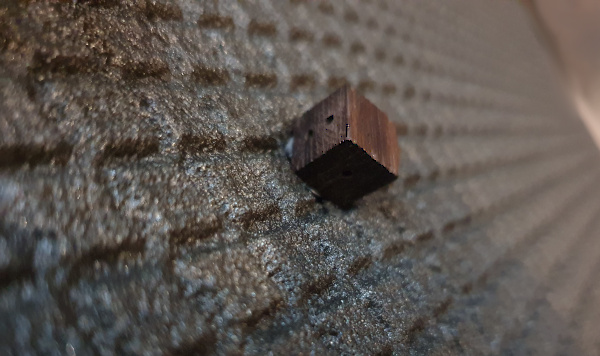
Wall mapping
This is a good question, to which I would answer, in layman's terms, phase correlations and reverberation time of individual frequencies is what changes. I would be interested to see if a carefully measured waterfall can see anything, for I'm sure nothing will be seen on a frequency response chart. Franck Tchang explains it by saying that Sugar Cubes affect the way the individual drivers in loudspeakers interact with the walls of the listening space, and thus the sound perception is changed. He goes on saying that the cubes closer to the floor affect the bass, and with the increasing distance from floor each cube, or horizontal line of cubes, interacts with a higher in frequency driver. This is - of course - nonsense until… until you try it out for yourself to find out that this is exactly how it appears to work. Why it works that way I have no idea, ultimately the laws of physic are the cause of the change. I find intriguing, however, how such seemingly negligible and subtle manipulations can accumulate into a completely new sonic picture, and how it can be achieved in a very controlled way.
You will understand how powerful a tool you have for shaping the sound field when you listen through your music collection (and I mean days, not hours) and hear what the contribution from each of the Sugar Cubes is. I don´t know if it would apply universally, but in my room the Sugar Cubes were more sensitive to rotation about their axes than to the accuracy of their absolute position on the wall. When I was getting up from my listening chair for about one hundredth time to find my path between components and cables and rotate one of the Sugar Cubes from 1 o’ clock to 2 o’clock, I found myself thinking For God's sake, what am I doing here? Then, as I sat back down and pressed PLAY on the remote and was flooded with music that suddenly sounded different and much better, I got an extra shot of energy to spend another hour moving and rotating another little Sugar Cube on the wall.
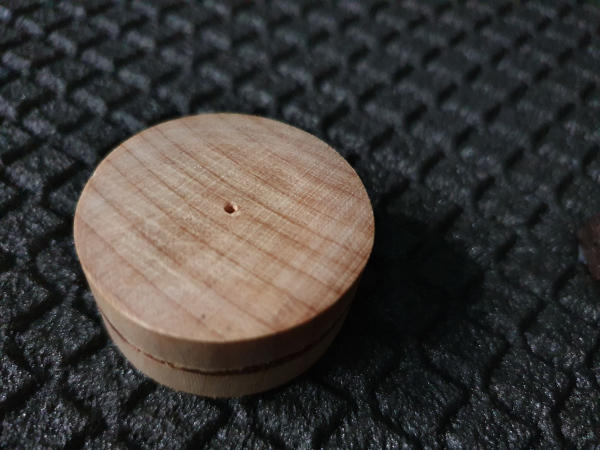
The Diffuser
I had 12 cubes on the wall, aligned in the perfect constellations and rotations, and it was time for the "diffuser". First of all, I'd like to say that this is a rather misleading name for a thing that has nothing to do with diffusion as acoustical sciences define it. Secondly, it is a round wooden piece with a hole in the middle, like a drawer knob, nothing you could not make yourself at home or in your garage. However, to my big surprise, the precision of the diffuser placement was quite crucial. Not only was the slightest tilt from the exact central and vertical flat position to the left, right, up, or down, clearly audible, but that stupid wooden piece behaved much like loudness controls on an amplifier. I warned you not to read any further, remember?
If the Sugar Cubes do not change the frequency response for the ear, the diffuser does, and significantly so. Actually, I had a fun to run from my listening position to the front wall every few minutes, turning or moving the wooden diffuser on it, and hearing instruments and vocals gain larger bodies, tangibility and weight, or vice versa, until everything clicked into place and the sound acquired unprecedented sweetness and transparency. The diffuser somehow mysteriously operates in the midrange and can deepen or thin the sound, make it richer and un-rich it, focus it and flatten it, depending on your preferences. Isn't it amazing?
Intermezzo
It is June at the time of writing this review. I have been playing with about fifty inconspicuous Synergistic Research HFT aluminum cylinders (and their specialized 2.0, X, WA, ECT, and GCT siblings) in my listening room since January [the review is upcoming]. The purpose and the way of use of the HFTs and the Sugar Cubes are similar, though their principles are quite different, but the jaw-dropping effect is just as powerful. I have never ever experienced such a remarkable transformation of sound in my listening room. I have put down enough notes from these experiments to write a book on the subject, and I dare to say I've become an HFT grandmaster since. The ASI Sugar Cubes surf a similar wave, and I was pleased to find that the two systems are highly complementary and mutually reinforcing. It is better to create a basic skeleton with HFTs as they are more efficient, but for finer tuning the Sugar Cubes are irreplaceable.
The last four
After all the effort, I was left with 4 cubes in my hand. No matter how hard I tried, I couldn't find a good use for them. Every time I managed to find good placements for one or another, after a while I decided that it was not an improvement and removed them. Therefore, the four remained in a drawer for 14 days, condemned to redundant oblivion.
Then one day I was surfing the internet and came across American ebony Shun Mook discs, which promised similar benefits like the ASI Sugar Cubes. However, for the Shun Mook different placements were recommended. While I was at it (I mean the internet search), I looked up where Acoustic System International prescribes to place their metal resonators. The combination of the two placement guides resulted in a map of locations that became candidates for placement of the last four Sugar Cubes.
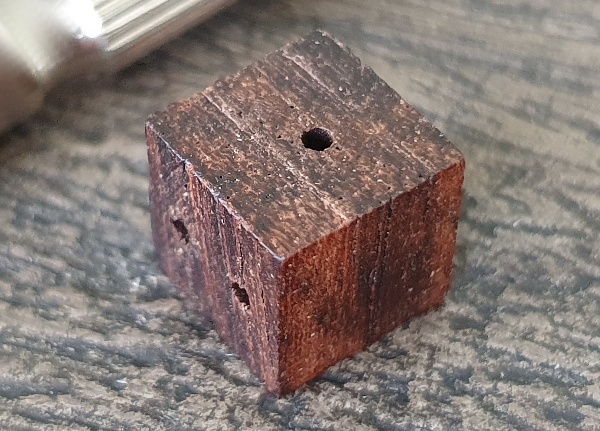
The first two Sugar Cubes found a new place quite quickly – on the wall close to the floor, outside the speakers. They had double effect: they enhanced lateral soundstage and contoured bass, while at the same time gave the bass more volume. Who wouldn't love that? The last two Sugar Cubes ended up all the way back in the corners up near the ceiling. Neither of these placements was intuitive, and if it were not for the tips from elsewhere (thank you, Shun Mook), I wouldn't have thought to attach the cubes at those places at all. It took me whole one day to fine tune these positions afterwards, but the final result exceeded all expectations.
If I previously considered the imaging of my system in my listening room exclusive (let’s put it straight: I've never heard better imaging at any room with any system), the finishing touch of the last four Sugar Cubes and the resulting sound just made me swallow dry. It is hard to describe, but the depth of image now encompassed the entire space, including the one next to me and behind me, the sound took on an exuberant tonality and dynamics, the contrasts improved, and the articulation reached the level of an absolutely real experience. The sound seemed to unfold in the room with intoxicating sweetness, almost as if the entire listening space was revolving around me in a kind of planetary motion. And no, I'm not writing about a multichannel.
An icing or a cake?
I am not able to tell if the Sugar Cubes can be used to address an untreated room acoustics. The manufacturer claims that it can and proves it at audio shows with convincing demos. Then the Sugar Cubes are a real audio cake. But maybe it is better to get the basics right with conventional treatment, and use Sugar Cubes as the proverbial icing on the cake. It's hard to quantify their influence in any way, but if I considered my home acoustics to be a very delicious cake already, the ASI Sugar Cubes added the icing, candles, and decorations. The diffuser was a bonus, a surprise girl jumping out of the cake.
There is one great thing about the ASI Sugar Cubes - they're cheap. They look simply, and you could probably even copy them easily, but I assume that it is not worth the effort - you are probably not going to bleed out by paying 200 euros for a set of cubes and a diffuser that are guaranteed to work. As far as I am concerned, the ASI Sugar Cubes are a totally unique and innovative approach for voicing a room to listener’s liking. Warmly recommended.
Price: 200 euro / set 17+1
Contact: Amarock Studio s.r.o., Kopřivnice, tel. +420 777 601 851
Manufacturer's website: https://asi-resonators.asi-resonators.com



